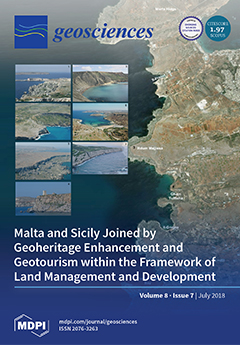Cap-rock integrity is an important consideration for geological storage of CO
2. While CO
2 bearing fluids are known to have reactivity to certain rock forming minerals, impurities including acid gases such as SOx, NOx, H
2S or O
2 may be present in injected industrial CO
2 streams at varying concentrations, and may induce higher reactivity to cap-rock than pure CO
2. Dissolution or precipitation of minerals may modify the porosity or permeability of cap-rocks and compromise or improve the seal. A calcite cemented cap-rock drill core sample (Evergreen Formation, Surat Basin) was experimentally reacted with formation water and CO
2 containing SO
2 and O
2 at 60 °C and 120 bar. Solution pH was quickly buffered by dissolution of calcite cement, with dissolved ions including Ca, Mn, Mg, Sr, Ba, Fe and Si released to solution. Dissolved concentrations of several elements including Ca, Ba, Si and S had a decreasing trend after 200 h. Extensive calcite cement dissolution with growth of gypsum in the formed pore space, and barite precipitation on mineral surfaces were observed after reaction via SEM-EDS. A silica and aluminium rich precipitate was also observed coating grains. Kinetic geochemical modelling of the experimental data predicted mainly calcite and chlorite dissolution, with gypsum, kaolinite, goethite, smectite and barite precipitation and a slight net increase in mineral volume (decrease in porosity). To better approximate the experimental water chemistry it required the reactive surface areas of: (1) calcite cement decreased to 1 cm
2/g; and, (2) chlorite increased to 7000 cm
2/g. Models were then up-scaled and run for 30 or 100 years to compare the reactivity of calcite cemented, mudstone, siderite cemented or shale cap-rock sections of the Evergreen Formation in the Surat Basin, Queensland, Australia, a proposed target for future large scale CO
2 storage. Calcite, siderite, chlorite and plagioclase were the main minerals dissolving. Smectite, siderite, ankerite, hematite and kaolinite were predicted to precipitate, with SO
2 sequestered as anhydrite, alunite, and pyrite. Predicted net changes in porosity after reaction with CO
2, CO
2-SO
2 or CO
2-SO
2-O
2 were however minimal, which is favourable for cap-rock integrity. Mineral trapping of CO
2 as siderite and ankerite however was only predicted in the CO
2 or CO
2-SO
2 simulations. This indicates a limit on the injected O
2 content may be needed to optimise mineral trapping of CO
2, the most secure form of CO
2 storage. Smectites were predicted to form in all simulations, they have relatively high CO
2 sorption capacities and provide additional storage.
Full article





